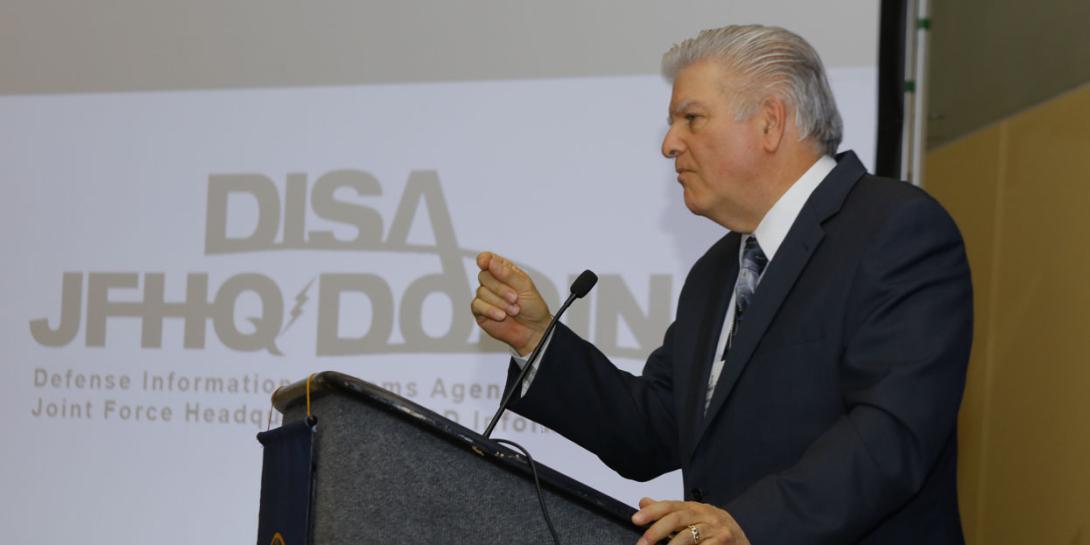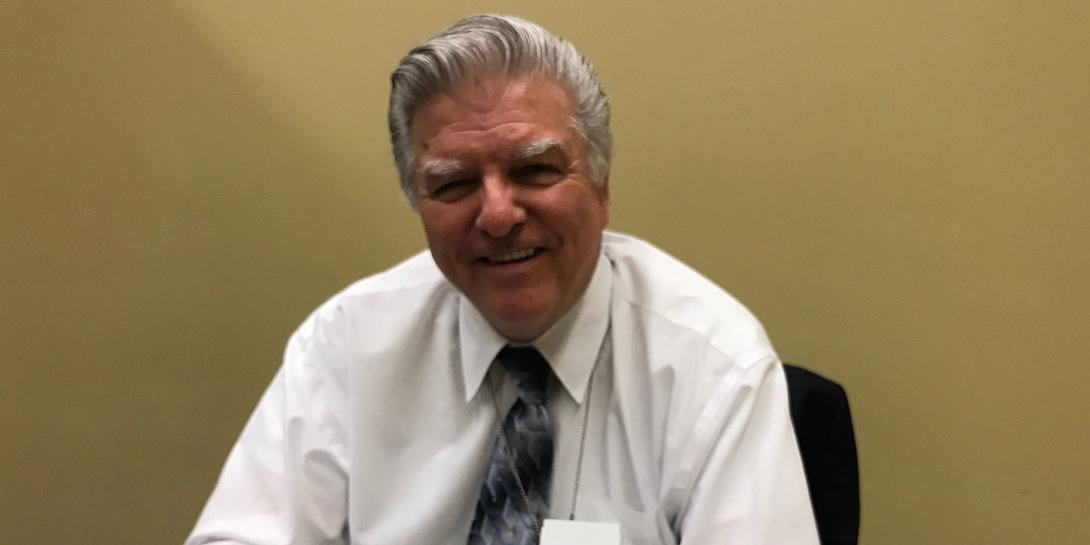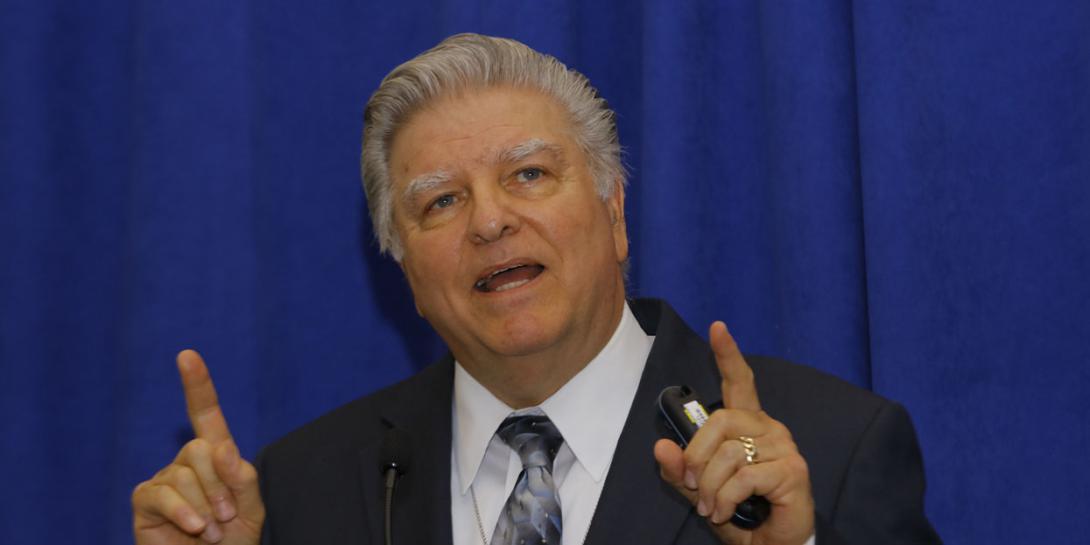DISA Executive Emphasizes Innovation
As the Department of Defense is working to improve lethality, it is making the transition to fight in the new domain of cyber, according to Anthony Montemarano, executive deputy director, Defense Information Systems Agency (DISA). The key to this evolution is innovation and harnessing emerging technologies to protect and defend the homeland. “We’ve got to get ahead of the adversaries,” he said.
Speaking to a room packed full of industry and government officials on Tuesday at the AFCEA Defensive Cyber Operations Symposium (DCOS) in Baltimore, and in an interview with SIGNAL Magazine, Montemarano called on industry to provide innovation.
More than ever, the agency is looking to collaborate with the commercial sector. He walked the DCOS attendees through a “who’s who” of DISA as a way to help the industry understand the organization, the key players and provide transparency in doing business with DISA. The executive deputy director warned the industry, however, not “to overpromise” on the capabilities they can deliver. Companies need to offer “a fair price” and should only protest contracts if they think the agency “legitimately” made a mistake. “We want industry to give us solutions and we want them to be innovative,” Montemarano said. “Innovation is very important to us.”
He admitted that one of the problems with DOD’s acquisition process is the specification of requirements to the point where it dictates a solution. “With the standards requirement process we have now, it doesn’t allow for innovation,” he said. “We are trying to set up our contracts so that there is that opening where the vendor can think. And we are embracing other transactional authorities (OTAs). In the case of innovation and information technology specifically, the OTA methodology is a perfect vehicle, which allows the vendor to come in with an innovative construct beyond what we would have thought.”
While the Defense Department is striving for innovation, it still has to bridge the gap between the generations, between the 21st century warfighters and the 20th century leaders. “We’ve got to come to grips with the demand signal we are getting from kids,” Montemarano said. “These kids think differently. They are the ones that are dictating our requirements. So we have to be anticipatory and recognize that they are going to come in and they are going to want the Internet and access to information and everything to be there.”
He noted that one of the biggest issues with a younger generation is the comfort they have with more advanced technologies, which makes it more difficult to impose dated security limitations. “In the past to get on a system, you had to put in multiple characters or codes,” Montemarano explained. “Right now, a lot of the cellphones have already gone to facial recognition or fingerprint identification. Why are [cellphone companies] doing that? They know kids are not going to be keying in numbers. So we’ve got to be anticipating that issue more.”
Leaders also need to evolve their understanding of the nature of warfare, Montemarano added. “We still think kinetically. We need to continue to elevate the importance of cyber,” he suggested. “We have to push our leaders to understand that the cyber threat can totally undermine the ability to conduct kinetic operations.”
He acknowledged that having a Cyber Command means that leaders at DOD are understanding the cyber threat. “That is a tremendous leap forward in terms of the old guys and gals accepting the fact that it is a new world, but that doesn’t mean that the culture is there yet. DISA’s purpose is to develop and operate and protect a cyber domain that is intended to enable warfighting, [but] we have to recognize that there is a battlespace, with attacks back and forth undermining the nation.”
DISA also will have to develop for the new era, and advance its relationship with the new Cyber Command. Montemarano suggested that the Joint Force Headquarters (JFHQ) “represents an excellent bridge.”
“Becoming a combatant command is no simple thing,” he said. “We’ve got to develop our relationships with the command, and Cyber Command has to mature itself. The beauty here is that DISA has a wealth of experience operating globally deployed infrastructures plus that wealth of infrastructure has to be at the behest of Cyber Command, that they can direct and exploit what it already provides them.”
Having Vice Adm. Nancy Norton, USN, director of DISA, at the helm “has been a great bridge and I think that will serve Cyber Command very well as we go forward, having the ability to influence that global infrastructure.”
As for the external pressures DISA is facing from Congress’ threat to eliminate the agency under legislation proposed by House Armed Services Chairman Rep. Mac Thornberry (R-Texas), Montemarano, was not phased. The executive deputy director, who has been with the agency for 29 1/2 years, has seen this before. “This always happens,” he said. “DISA has been fulfilling a mission since 1960, when we called it DCA. DISA will continue. Is it going to have a logo change or a name change? It is really not important. What is important are the missions that DISA is currently responsible for, and are they going to continue. Absolutely. It is not like you are going to turn off a global network or turn off the data centers. DISA has some absolutely critical missions that we are going to continue on with.”
At the end of the day, he said, what is important to him and so many DOD employees is their role in defending the nation. “What’s important to us is that we have a mission to do and we have a heck of a lot of things to be proud of. And I will tell you today things are happening out there because of DISA being on the ground. And that is going to continue. We can’t let this kind of thing distract us. What is important to this agency is the health and welfare of those men and women that go in harm’s way.”







Comments